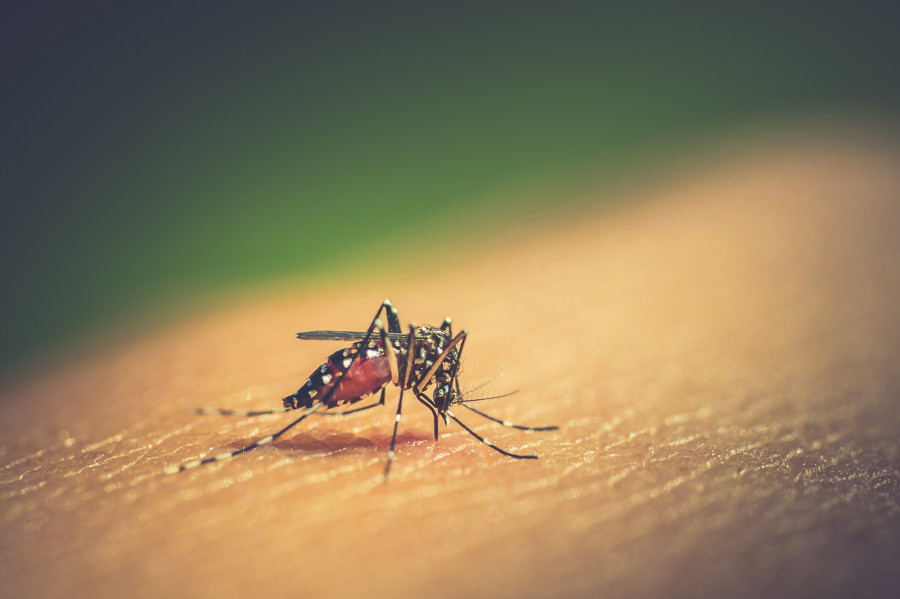Health
Authorities scramble to contain spread of mosquitoes in mountain region
As deadline to eliminate malaria nears, health authorities have been distributing insecticide-treated mosquito nets and spraying insecticides as preventive measures in mountainous districts.
Arjun Poudel
Last month, authorities at Himali Rural Municipality of Bajura district sprayed insecticides in wards 4, 5, 6, and 7, which have a high density of mosquitoes that cause malaria.
Officials said that they have been preparing to disperse the liquid fog again, given the high risk of local transmission of the deadly disease in the area.
“We will spray insecticide again in the high-risk areas,” Raj Bahadur Bhandari, chief administrative officer at the rural municipality, told the Post over the phone from Bajura. “We have also been providing insecticidal nets to pregnant women and new mothers of the high-risk area.”
Spraying of insecticides and distribution of insecticidal nets in the affected areas are among the measures taken by the authorities to prevent the outbreak of the disease, which poses challenges in meeting Nepal’s goal to eliminate malaria by 2025.
Officials said that they have supplied rapid diagnostic kits to the local health facilities, stepped up surveillance measures, launched an awareness drive, and provided entomological training to health workers to find the vector causing malaria at the earliest.
Earlier, the Ministry of Health and Population had sought help from India for intervention measures to lessen imported malaria cases in Nepal. Officials from both countries agreed to share information on malaria cases to make intervention measures effective in their respective countries.
Nepal is one of the member countries of the UN health body’s E-2025 group that have the potential to eliminate the disease by 2025. In April 2021, the UN health agency launched the E-2025 initiative to halt the transmission of malaria in 25 identified countries by 2025.
To eliminate the disease within the deadline, the country has to reduce the indigenous malaria cases to zero from the start of next year, which seems almost impossible as more cases are being reported from the areas considered non-endemic in the past.
At least 29 indigenous cases of malaria have been reported in Nepal since the start of 2022.
“Until a decade ago, we did not have any problem caused by mosquitoes and malaria,” Bhandari said. “Now it is very difficult to stay here at this time due to the rise in temperature and high density of mosquitoes.”
Bajura is among the mountainous districts that were considered non-endemic to malaria in the past.
Along with Bajura, four other mountainous districts—Humla, Mugu, Kalikot, and Baitadi—have been affected by malaria. Some districts of hills—Dadeldhura, Achham—and districts of Tarai—Surkhet, Kailali, Saptari, Kapilvastu, Kanchanpur, Banke, and Bardia—have been reporting more cases, where authorities concerned have launched programmes to spray insecticide and distribute insecticidal net.
Dr Gokarna Dahal, chief of the Vector Control Section at the Epidemiology and Disease Control Division, said problems of disease-spreading mosquitoes are more in mountainous and hilly regions compared to the districts of Tarai region.
“We have been focussing our programme on the affected areas,” he said.
Rising temperature in the mountainous region provided a favourable environment for the vector to survive and spread, posing a serious challenge to Nepal’s target to eliminate malaria from the country, experts say.
“Problems are being detected in new areas that were considered no-risk areas in the past,” said Dr Madan Koirala, a malaria surveillance medical coordinator of Karnali Province. “Along with indigenous cases, imported cases of malaria, especially from India, are posing a challenge to us which could lead to local transmission.”
Of 485 total malaria cases detected in the last fiscal year, 433 were imported cases, mostly from India. The other 52 were indigenous cases. The Health Ministry said that Sudurpaschhim and Karnali provinces reported 17 indigenous cases each in the last fiscal year. Madhesh Province reported eight, Lumbini Province reported six, and Gandaki and Bagmati provinces reported two indigenous cases each.
Officials said that as many as 10,192,669 people in 2,551 wards throughout the country are at high risk of malaria infection.
Experts say along with focussing on the preventive measures—spreading insecticide, distributing insecticidal nets, and launching awareness drives—authorities concerned should also develop mechanisms for timely response to an outbreak of the infection and, as climate change has increased the burden of the vectors, promote an adaptation strategy.
“We can minimise the risks and prevent further spread of the disease if we have a mechanism in place for timely response,” said Dr Manoj Pande, a malaria surveillance medical coordinator at Sudurpaschim province.
A United Nations report ‘Climate Change 2022: Impacts, Adaptation and Vulnerability’ states that at least six major vector-borne diseases affected by the climate drivers have recently emerged in Nepal and are now considered endemic, with climate change implicated as the primary driver.
The report also shows increasing evidence that global warming has extended the elevational distribution of Anopheles, Culex, and Aedes mosquito vectors above 2,000 metres in Nepal.
Malaria is caused by Plasmodium parasites. Infected female Anopheles mosquitoes carry these deadly parasites, according to the World Health Organisation.
To earn malaria-free status in 2026, Nepal needs to bring down indigenous cases or local transmission of the disease to zero by the end of 2022 and sustain zero cases for three consecutive years, according to the World Health Organisation.
International experts will carry out a final verification after completion of the process of declaring the country free of malaria.
Certification of malaria elimination is the official recognition by the UN health body of a country's malaria-free status.




 10.12°C Kathmandu
10.12°C Kathmandu














